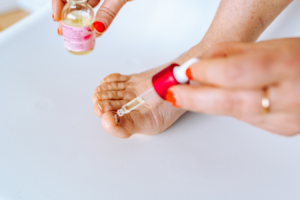Foot fungus occurs when there is a fungal infection in this part of the body.
It usually affects mainly the toes (interdigital area), but can spread to the sole, heel, or back.
Other times, fungus appears on the toenails, which is known as onychomycosis.
This part of the body is often covered by shoes and experiences increased sweating. This creates ideal conditions for the proliferation of these microorganisms: a humid, warm, occlusive, and dark environment.
Typically, the fungi responsible for this infection are yeasts, specifically the Candida species.
Skin fungus can easily spread to other parts of the body or to other people. Treatment can also be a lengthy process.
For all these reasons, it is important to know the causes of foot fungus and its main symptoms.
Likewise, a correct diagnosis is essential to ensure effective treatment and prevent complications such as bacterial superinfections.
Why do fungi appear on the skin of the feet?
Foot fungus can appear for different reasons:
- Sweat
Excessive sweating on the feet creates a humid environment ideal for the growth of fungi.
This is why people with excessive sweating or hyperhidrosis are at greater risk of developing foot fungus.
- Occlusive footwear
Wearing shoes that do not allow adequate breathability also increases the risk of foot fungus.
The same thing happens with socks made with materials that do not allow the feet to ‘breathe’.
- Lack of hygiene and care
Poor hygiene habits can promote the development of foot fungus. For example, not washing your feet frequently or not changing socks if they’re damp from sweat.
Not drying your feet properly after a shower or bath is another factor that contributes to their appearance.
In the case of toenail fungus, other causes can contribute to this fungal infection.
These include nail biting, permanent or artificial manicures, or keeping your feet in water for long periods.
- Warm and humid environments
High temperatures and humidity promote increased sweating and, therefore, increase the risk of foot fungus.
This explains why these types of infections are especially common during the summer months.
- Contact with contaminated surfaces or objects
Direct contact with contaminated towels or objects is another risk factor.
Walking barefoot in humid environments (changing rooms, public showers, swimming pools, saunas, etc.) is also a common cause.
Foot fungus is one of the most common pool infections for these reasons.
Athletes tend to suffer from foot fungus more frequently because they experience increased sweating in the area and do not always wear appropriate footwear.
Also, those with foot or nail injuries, skin diseases such as psoriasis, diabetes, or other diseases that affect the immune system.
Symptoms of foot fungus
The symptoms of this fungal infection can be diverse and vary depending on the severity. However, they tend to be bothersome and uncomfortable.
- Itching
One of the first signs is the appearance of intense itching. This is usually between or underneath the toes, which can eventually spread to other areas.
Itching of the feet may increase when removing socks and shoes.
Peeling of the skin may occur in the affected area.
- Inflammation
Inflammation of the skin can cause it to appear red, purple, or grayish, depending on the skin color.
A burning or stinging sensation is also common.
Itching between the toes is often one of the most characteristic symptoms of fungus, as is skin redness and scaling.
- Cracked skin
Foot fungus can cause skin maceration and the appearance of cracks and fissures. Vesicles or blisters may also appear.
These can be very painful and make it difficult to walk or wear shoes.
- Bad smell
The presence of fungi can be the source of bad foot odor.
The infection encourages the proliferation of bacteria, which are responsible for producing an unpleasant odor.
- Changes in the nails
Having yellow or whitish nails is one of the main symptoms of fungus in this part of the body.
Split or brittle nails are also characteristic. Sometimes, they can even detach from the nail bed, causing the toenails to fall out.
In other cases, they may thicken and/or cause deformities to appear.
Types of foot fungus
Different types of fungi can affect the feet.
- Athlete’s foot
It is the most common type of foot fungus and usually presents with the characteristic symptoms of this infection.
- Nail fungus
This infection usually appears first in the nails and causes changes in their appearance.
- Tinea versicolor
This type of fungal infection usually manifests as white or brown patches that may be itchy and scaly.
- Tinea cruris
This fungal infection, also known as jock itch, originally affects the thighs and genitals. However, it can spread to the feet.
The skin is usually red, scaly, and itchy.
Treatment for foot fungus
Treatment for foot fungus will depend on the type of infection and its severity.
It is essential to adhere to the guidelines indicated, as they can be a persistent problem.
Therefore, it is important to be consistent with treatment even if you do not experience immediate improvements.
In this sense, it must be taken into account that the healing process may be prolonged.
Home remedies that may interfere with treatment, promote the spread of fungus, or lead to complications should also be avoided.
- Foot hygiene
You should wash your feet every 12 hours with a soap with an acidic pH.
Then, they should be dried well by gently patting them dry.
- Topical drugs
After foot hygiene, apply the indicated treatment.
In this sense, topical antifungal medications are the first therapeutic option.
Among the most commonly used active ingredients are bifonazole, clotrimazole, and terbinafine.
These usually come in cream, lotion, spray, or powder form.
In the case of toenail fungus, the most commonly used active ingredients are amorolfine, ciclopiroxolamine, terbinafine, and imidazoles.
The format chosen for this type of fungus is medicated or cream nail polish.
- Products to control sweat
It is recommended to combine topical treatment for foot fungus with products that help reduce sweating.
These are usually powders or sprays applied to the feet and shoes. Their active ingredients include aluminum chlorohydrate, zinc oxide, irgasan, and silica.
- Antiseptics
Foot fungus can cause cracks, fissures, or blisters that ooze.
Using an antiseptic, astringent, and anti-exudative product promotes healing and minimizes the risk of bacterial superinfection.
- Oral drugs
Oral antifungal medications may be prescribed when infections recur or do not respond to topical treatments.
The most commonly used drugs are itraconazole, terbinafine, and fluconazole.
- Antibiotics
In case of bacterial superinfection, topical and/or oral antibiotics may also be prescribed.
How to prevent foot fungus
Certain foot care habits can help prevent the appearance of skin fungus.
- Do not walk barefoot in public showers, locker rooms, or swimming pools. Flip-flops must always be worn.
- Wash your feet with soap and, above all, dry them well, especially between your toes, where moisture is most likely to accumulate.
- Wear comfortable and appropriate footwear. Whenever possible, it’s preferable to wear open-toed shoes that allow your feet to breathe.
- Change your shoes frequently, wash them whenever possible, and avoid wearing the same shoes two days in a row. It’s a good idea to let them air out before wearing them again.
- Wear socks made of materials that help keep your feet dry and promote breathability.
Cotton is very breathable yet retains heat. Therefore, materials such as polyester, nylon, or spandex are often recommended.
This is especially important not only for preventing foot fungus, but also for foot blisters.
Socks should be changed whenever necessary.
- Socks, shoes, and pedicure materials and products should not be shared.
- Use antiperspirant powders or sprays to help control sweat and prevent foot fungus. These products often have a deodorizing effect that can help with foot odor.





















+ There are no comments
Add yours